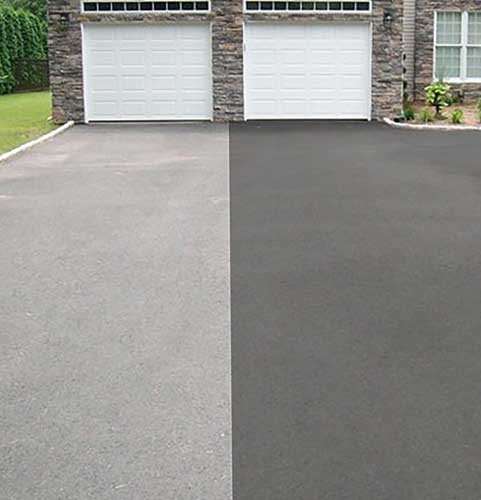Swift Solutions for Asphalt Spot Repair: Optimal Securing Methods
Wiki Article
Cold Mix Asphalt Vs. Hot Mix Asphalt: Which Is Right for You?

Make-up Distinctions
Cold mix and hot mix asphalts differ dramatically in their composition, with distinct attributes that impact their efficiency and applications. Cold mix asphalt is generated by emulsifying the asphalt binder with water and an emulsifying agent prior to mixing it with aggregate. This technique permits for the asphalt to be workable at lower temperature levels, making it perfect for temporary repair work and for use in cooler climate condition. Hot mix asphalt, on the various other hand, is produced at high temperature levels, typically in between 300-350 ° F, which aids to attain better compaction and a more durable final item. The hot mix asphalt production procedure includes heating up the accumulation and asphalt binder separately before integrating them at the asphalt plant.
Moreover, cool mix asphalt tends to be less thick and extra adaptable than hot mix asphalt. This versatility makes it better matched for areas with higher degrees of activity, such as driveways or roadways with hefty web traffic. On the other hand, hot mix asphalt is understood for its high longevity and resistance to rutting and fracturing, making it a recommended option for highways and high-traffic roads where long life is critical.
Setup Process Variances
The process of mounting chilly mix and hot mix asphalt exhibits remarkable variances in their procedures and requirements. Cold mix asphalt, being an extra versatile material, can be used straight from the bag or container onto the crater or harmed area. It calls for very little preparation work, such as cleaning the location and compacting the cool mix with hand devices. This makes it a convenient alternative for short-lived and quick fixes. In comparison, hot mix asphalt requires a more sophisticated installation procedure. It involves warming the blend to heats prior to laying it down on an appropriately prepared base. The preparation includes compacting the base, using a tack coat, and utilizing hefty machinery like pavers and compactors for a long lasting and smooth finish. Because of the home heating demands, hot mix asphalt setups are usually lugged out by professionals with customized devices, making sure a more long-term and structurally sound outcome.Resilience and Durability Elements
When thinking about asphalt options, resilience and durability are vital elements to evaluate for long lasting pavement efficiency. Hot mix asphalt (HMA) is known for its extraordinary longevity and longevity.
In regards to longevity, HMA typically exceeds CMA as a result of its superior toughness and resistance homes. HMA pavements have a longer life span, calling for much less regular repair work and upkeep, which can translate to set you back financial savings in the lengthy run. Additionally, HMA pavements are a lot more quickly personalized to satisfy specific job requirements, better boosting their sturdiness.
Expense Considerations
Considering the financial ramifications is a critical aspect when reviewing the selection in between hot mix asphalt (HMA) and cool mix asphalt (CMA) for sidewalk projects. While the initial expense of warm mix asphalt is normally higher than cold mix asphalt that of cool mix asphalt, HMA frequently provides an extra cost-effective option in the lengthy run due to its superior sturdiness and durability.In addition to product prices, it's important to consider the expenditures connected with installment and maintenance when contrasting HMA and CMA. HMA usually requires specific equipment and skilled labor for correct installment, which can affect total job expenses. Alternatively, CMA is less complicated to collaborate with and can frequently be used making use of easier methods, potentially reducing setup expenditures. Eventually, the choice in between HMA and CMA ought to consider not simply the initial cost yet also the lasting monetary implications to identify the most economical choice for the details sidewalk task.
Environmental Effect Comparison
Contrast of the environmental effects between warm mix asphalt (HMA) and cold mix asphalt (CMA) discloses unique distinctions in sustainability methods. HMA manufacturing needs high temperatures, leading to enhanced energy consumption and greenhouse gas exhausts.Additionally, the use of CMA frequently involves recycling existing asphalt pavement, advertising resource preservation and reducing the quantity of waste sent out to landfills. By choosing for CMA over HMA, road building and construction projects can add favorably to ecological conservation efforts.
Verdict
In verdict, the option in between chilly mix asphalt (CMA) and warm mix asphalt (HMA) depends on various elements such as composition, setup process, durability, durability, price, and environmental impact. asphalt repair. While CMA provides a cost-efficient and quick solution for minor repairs, HMA makes certain exceptional sturdiness and longevity for hefty web traffic locations. Take into consideration these factors thoroughly to determine which kind of asphalt is the ideal option for your paving requires

Taking into consideration the financial ramifications is an important aspect when reviewing the selection between hot mix asphalt (HMA) and cool mix asphalt (CMA) for pavement projects. While the first expense of warm mix asphalt is commonly higher than that of cold mix asphalt, HMA typically provides a much more affordable option in the lengthy run due to its remarkable toughness and longevity. asphalt patch repair.Comparison of the environmental effects between warm mix asphalt (HMA) and chilly mix asphalt (CMA) discloses distinctive distinctions in sustainability practices.In conclusion, the selection in between cool mix asphalt (CMA) and warm mix asphalt (HMA) depends on different variables such as structure, installment process, longevity, durability, cost, and environmental influence
Report this wiki page